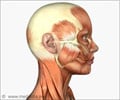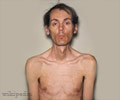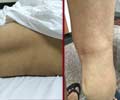In cases of muscle wasting that afflicts cancer or AIDS patients, the body turns on itself and breaks down skeletal muscle proteins to liberate amino acids.
In cases of muscle wasting that afflicts cancer or AIDS patients, the body turns on itself and breaks down skeletal muscle proteins to liberate amino acids. In a new study published online June 8 and in the June 15, 2009 print issue of the Journal of Cell Biology, Shenhav Cohen, Alfred Goldberg, and colleagues show that muscle atrophy is a more ordered process than was pre viously thought. These researchers find evidence that enzyme MuRF1 selectively degrades the thick filaments in muscle, while bypassing the thin filaments.
We depend on skeletal muscles because they can produce movement, but they serve another purpose too. "Skeletal muscle is a protein reservoir that can be mobilized in times of need," says Goldberg. The structural core of a muscle cell is the myofibril, composed of myosin-containing thick filaments and actin-containing thin filaments. During atrophy, this structure is disassembled, but exactly how was not known. MuRF1, an atrophy-related gene, is a ubiquitin ligase that "ubiquitylates," or tags a protein, by attaching a ubiquitin molecule, marking it for degradation by the cell. It was unclear when and how ubiquitylation was involved in disassembling skeletal muscles. The researchers triggered atrophy in mice containing defective MuRF1 (lacking its RING-finger domain crucial for ubiquitylation). These mutant mice break down less muscle than wild-type mice, and less ubiquitylation takes place in the mutants.Cohen and colleagues found that MuRF1 targets the thick filament, demolishing various components in a specific order. The researchers hypothesize that removal of certain thick filament components first permits subsequent MuRF1 access to the myosin heavy chain. However, MuRF1 doesn't exert the same power over the thin filament, which began to come apart even when MuRF1 was absent.
"Up to now, people thought the muscle just gets smaller" during atrophy, Goldberg says. Instead, these findings paint a picture of a well-regulated process of degradation and disassembly. This mechanism "allows the muscle to still be a muscle and function," Goldberg says. "Atrophy doesn't just destroy muscle cells, like apoptosis." The results indicate that MuRF1 doesn't have to wait for caspases or calpains to "pre-digest" the myofibril components. The work also bears on the practical question of whether atrophy can be halted or reversed with drugs. "It argues against MuRF1 inhibitors" for this purpose, Goldberg says, because the enzyme is responsible for degrading only some muscle components, whereas others fall victim to other ubiquitin ligases and autophagy. Inhibitors that work upstream to block signals that activate ubiquitin ligases and initiate autophagy are a better bet.
Source-Eurekalert
RAS













